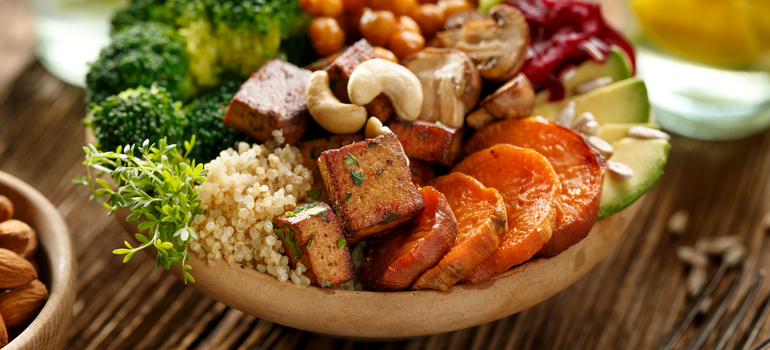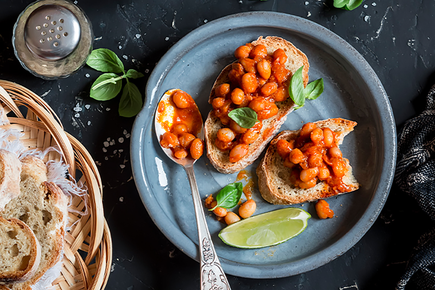Power proteins
The good news is that most of us get all the protein we need – but we might be eating too much of the wrong type.
Protein is essential for human health and survival. Plant and animal proteins are made up of 20 amino acids, all of which are needed for good health. Our bodies can produce 11 of these amino acids themselves, but the remaining nine need to come from our food.
There's always been a strong cultural belief that to get enough protein, you need to eat meat. However, a recent tide of scientific literature recommends less red and processed meat, and more legumes, nuts, seeds and fish.
It’s true that beef, lamb and chicken can help you meet your protein needs, but they can also increase the amount of saturated fat and dietary cholesterol in your diet. A diet high in red and processed meat is also linked with weight gain and bowel cancer. And eating too much red meat may increase your risk of type 2 diabetes. So it’s best to limit your red meat intake and keep processed meats to a minimum (or avoid them altogether).
And why not try to include a variety of other foods in your meals, such as lentils and other legumes (such as chickpeas and kidney beans), nuts, quinoa, and soy foods – these are excellent protein sources and may also help to protect you against lifestyle diseases.
Check our article on high protein, low carb diets for more information on the health impacts of eating a high protein diet.
How much protein do you need?
The National Health and Medical Research Council recommends that men up to age 70 eat 64g of protein per day to stay healthy, and women up to age 70 eat 46g (unless pregnant or breastfeeding).
Recommended dietary intake (RDI)
| Men | |
| 19+ years | 64g/day (0.84g/kg) |
| 70+ years | 81g/day (1.07g/kg) |
| Women | |
| 19+ years | 46g/day (0.84g/kg) |
| 70+ years | 57g/day (0.94g/kg) |
| Pregnancy | 60g/day (1.00g/kg) |
| Lactation | 67g/day (1.10g/kg) |
Source: Nutrient Values for Australia and New Zealand
The most recent Australian Health Survey and the New Zealand Adult Nutrition Survey showed that many Australian and New Zealanders are consuming 20-40g more protein than recommended. That’s not necessarily bad for growing teenagers, people with illnesses or certain injuries, and highly active individuals (eg athletes) may require extra protein to support their higher energy needs.
For example, if you’re an endurance or strength athlete trying to gain muscle mass in your initial stages of training, your protein needs can increase up to 1.7g/kg of body weight per day, meaning that going over the standard recommendations is recommended. If you’re not sure, check with your dietitian to make sure you’re getting the right amount.
How much is a serve?
According to the Australian Dietary Guidelines, the following provide a standard serve of protein:
1 cup (150g) of legumes (eg lentils, red kidney beans, chickpeas)
170g of tofu
¼ cup (30g) of nuts and seeds (eg almonds, peanuts, sunflower seeds)
2 large eggs
65g of cooked lean red meat (90-100g raw)
80g of cooked lean poultry (100g raw)
100g of cooked fish fillet (115g raw)
Foods that are not listed in the ‘legumes/beans, nuts and seeds, meat, poultry and fish’ group can also provide valuable sources of protein, including:
dairy and dairy alternatives, eg dairy milk, soy milk and yoghurt
wholegrains, including wholegrain wheat, brown rice, barley, quinoa, buckwheat and amaranth.
You may notice the dietary guidelines say that a serve of meat is not very big, so if you’re eating a 200g steak with each meal, you may want to cut this down or eat it only a couple of times a week. The number of serves you require from the foods listed above generally vary between 2-3 per day, but can depend on your age, gender and activity levels – so speak to your doctor and dietitian if you’re unsure.
So when it comes to choosing foods for protein, aim for variety! Try wholewheat breakfast biscuits with dairy milk, soy milk, yoghurt and/or nuts and seeds with your breakfast, a lentil and quinoa salad with veggies with lunch, a nut and seed mix for an afternoon snack, and a vegetable stir-fry with marinated tofu and brown rice for dinner .
High-protein foods
Plant protein source | Quantity | Protein content |
|---|
| Legumes | | |
| Tofu | 170g | 19.7g |
| Tempeh | 100g | 18.5g |
Soy beans/ Edamame beans | 1 cup cooked (150g) | 17.4g |
| Red kidney beans | 1 cup cooked (150g) | 11.8g |
| Lentils | 1 cup cooked (150g) | 11.4g |
| Chickpeas | 1 cup cooked (150g) | 10.8g |
Soy milk | 1 cup (250 mL) | 8g |
| Nuts and seeds | | |
| Sunflower seeds, raw | ¼ cup (30g) | 5.8g |
| Pumpkin seeds, raw | ¼ cup (30g) | 9.3g |
| Almonds, raw | ¼ cup (30g) | 6g |
| Cashew nuts, raw | ¼ cup (30g) | 5.3g |
| Peanut butter, no added salt or sugar | 1 tbsp (20g) | 5.9g |
| Brazil nuts, raw | ¼ cup (30g) | 3.6g |
| Wholegrains | | |
| Wholegrain wheat | 2 wholegrain wheat breakfast biscuits (30g) | 3.8g |
| Quinoa | ½ cup cooked (90g) | 3.3g |
| Bulgur wheat | ½ cup cooked (120g) | 2.9g |
| Brown rice, long grain | ½ cup cooked (90g) | 2.4g |
| Buckwheat | ½ cup cooked (90g) | 2.4g |
Animal foods | | |
| Lean chicken breast | 80g cooked | 23.84g |
| Barramundi fillet | 100g cooked | 22.80g |
| Lean beef steak | 65g cooked | 20.74g |
| Eggs | 2 large (120g), hard boiled | 14.88g |
| Dairy yoghurt, low fat, natural | ¾ cup (200g) | 12.75g |
| Dairy milk, low fat | 1 cup (250ml) | 9.50g |
Source: NUTTAB 2010, Food Standards Australia and New Zealand, USDA Food Composition Databases
Can I get enough protein from plants?
Contrary to popular thought, vegetarians and vegans can easily meet their recommended protein needs. Not only will plant proteins (such as legumes and beans) fill you up and keep you lean, they will also keep your cholesterol low. Legumes are known as the food most associated with living a longer and healthier life.
All your protein amino acid needs can be met with a daily variety of wholegrains, legumes, nuts, seeds, soy products and vegetables. The amino acid ‘score’ for soy protein, quinoa and amaranth is actually very similar (if not identical) to red meat, making it a great source of amino acids without the saturated fat and cholesterol that comes with meat.
Check our article Vegetarian diets - are they good for you? for more information.

.png)


